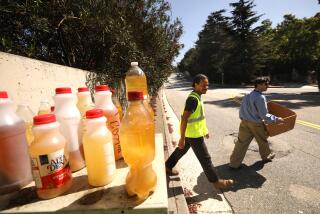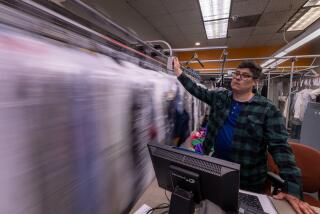The Celluloid Time Capsule
- Share via
The hippie-burnout drama “Cisco Pike” is a movie in which the optimism of the 1960s slips into the disappointing loneliness that Los Angeles can cultivate like no other city.
It is a cruel irony, then, that the 1972 film sank without a trace upon its release, so concerned is its hero’s need for recognition and reward. Although both a Marvel Comics character and a Chicago indie-rock band have taken the name Cisco Pike, the film-- despite unforgettable performances by Kris Kristofferson in the title role, Gene Hackman, Karen Black and Harry Dean Stanton--has never had enough exposure to become known even as a cult classic.
It struggled for its audience from the beginning: Bill L. Norton, a 27-year-old filmmaker, first pitched the story (original title: “Dealer”) in 1969 to Columbia exec Gerald Ayres, who then left the studio to produce it. After countless rewrites and last-minute cast changes, the film was shot on location (for less than $800,000, with the smallest Hollywood crew Columbia had ever used) in late 1970 and early 1971. And then . . . nothing.
While Columbia sat on the picture, Gene Hackman’s star-making turn in “The French Connection” was filmed and released to theaters, and magazines such as Seventeen went ahead and published what were supposed to be tie-in profiles of Kristofferson. It was released to one theater in Los Angeles, where it played for several weeks before closing. Norton couldn’t get work as a director until “More American Graffiti” in 1979. In the ‘80s, the late Z Channel head Jerry Harvey, who had resuscitated interest in other mishandled releases such as “Heaven’s Gate” and “Once Upon a Time in America,” was unable to persuade Columbia to license the rights for broadcast. Never officially available on VHS, “Cisco Pike” has nonetheless circulated on bootleg videotapes, and has occasionally surfaced in various “great lost films” series at revival theaters.
It was finally released on DVD this year to little fanfare--so little that Norton didn’t know of the release until I contacted him. In a final indignity, the packaging was adorned with this supremely backhanded compliment from critic Leonard Maltin: “Surprisingly Good.”
But “Cisco Pike” is much more than that: It belongs in a pantheon of films--along with “Sunset Boulevard,” “Mi Vida Loca” and “Valley Girl”--that have managed to capture in-the-moment pieces of the L.A. landscape that are no more.
Kristofferson’s character, Cisco Pike, can’t accept that his 1966 song “Breakdown” will stand as his only hit. Now he sends out demo tapes, collects rejections and bitterly corrects music-biz slicksters about the trivia of his distant career:
“I saw you guys at the Forum in, what was it, ‘68?”
“The Shrine ’67.”
What everybody does agree on is that Pike is good at dealing drugs. But a recent bust and the pleas of his girlfriend Sue (Karen Black) have nudged him to quit.
Enter Sgt. Leo Holland (Hackman), a narcotics officer whose health concerns and pension dissatisfaction drive him to a cannabis-unloading scheme: If Cisco sells $10,000 worth of Holland’s 100 seized kilos in 59 hours, Holland will help get Cisco off on a technicality--and Cisco can keep whatever is left after Holland gets his money. Along the way, Cisco runs into reminders of his longed-for past, such as Rex (Doug Sahm), a former record-chart peer who is still a success, and Jesse Dupre (Harry Dean Stanton), a junkie and former bandmate who has left his wife and children to return to L.A. Added to this is the indignity of making drug deals at recording studios and a rock club where he used to play. Even rival dealer Buffalo (Antonio Fargas), whose gaudy jewelry and scepter (adorned with the head of an African king) anticipate the blaxploitation aesthetic, rubs salt in the wounds: “What happened? I thought you could make a million dollars in the record business a couple of years ago.Now you broke. Ain’t that a bitch!”
But it’s a sense of place, rather than plot, that makes “Cisco Pike” special. How better to depict the fallen musician’s drought of luck than by opening on him, guitar case in hand, walking on broken sidewalks past the murky canals of rundown Venice?
With its focus on neighborhood hangouts and desperate meet-ups, rather than the freedom of the highways, “Cisco Pike” literally stays at street level. And so we’re treated to a look beyond the postindustrial transformation that was underway in the city--1970 was, after all, the year that Joan Didion’s Maria Wyeth indulged her freeway-driving addiction in “Play It as It Lays.” Within two years, the Riverside, San Gabriel, Ventura, Orange and Antelope freeways also would be completed.
Although there are plenty of generic locations befitting the rootless anonymity of Los Angeles--a hotel entrance, a strip club, a studio sound stage, an abandoned parking lot--Cisco Pike’s Los Angeles has a specificity that’s rare for films of its era.
Even as Cisco laments the passing of the ‘60s, the audience is privileged to see a close-up of what, in retrospect, seems like the lost city of Los Angeles.
By 1958, Venice had so faded from founder Abbot Kinney’s dreams of glory that Orson Welles chose it to stand in for a decrepit Mexican border town in “Touch of Evil.” The decay intensified during the next decade, with more than 500 buildings demolished in the early 1960s alone. “Cisco Pike” depicts the neighborhood less than a year after the first of several arson fires ravaged the Pacific Ocean Park pier (bankrupt since 1967); the script describes “a community of the young and poor. The now generation, now wasted on reds and wine, sits beside pensioners on the boardwalk benches.”
Cisco makes his home on Ocean Front Walk south of Ozone, near the pier’s ruins, a constant reminder of what was shattered in only a few short years. What had survived through 1970 was Olivia’s, the Southern food and UCLA film student hangout immortalized by the Doors’ song “Soul Kitchen,” and it’s here that Cisco meets Buffalo for a plate of biscuits and chicken, or maybe to get one last look at the neighborhood.
By the time the film was released, the 18-mile bicycle path along Ocean Front Walk had opened, attracting a new, distinctly ‘70s crowd. In his 1973 novel “The Big Fix,” Roger L. Simon’s description of Venice reveals a shift from counterculture character to mere tackiness: “The decaying monuments of another age soon disappeared, giving way to the pre-fab mausoleums of our own--low-slung motel structures with names like Neptune’s Kingdom and Tahitian Singles Village West.”
Venice was rebuilt and gentrified on the foundation of this homogenous seediness. Some might argue that when the artists were priced out, bohemianism was relegated to piercing booths and T-shirts for tourists. Olivia’s no longer exists, replaced by, irony of ironies, the California Heritage Museum.
The exterior of our hero’s boardwalk home is a high-end skate and bike rental shop, while the Main Street apartment where the interiors were shot now houses a designer denim store. South of Windward Avenue, the mural that Kristofferson walked by in the opening credits is gone. Another building now covers the wall where it was, and the only part of the surface that’s still exposed sports a familiar spray-painted epithet. The sidewalks are no longer broken, and the canals were restored in the 1990s. Lots along the canals, priced at $25,000 in the late 1960s, have broken the million-dollar barrier.
Not everything has gone upscale, though. The boatyard on the southeast corner of Abbot Kinney and Venice Boulevard, where Cisco made one deal, is now an empty lot.
“Cisco Pike” isn’t just about Venice--after all, it was envisioned by Norton as an American take on “La Dolce Vita,” a travelogue of urban vignettes. The decadence of Rome is supplanted by an earthiness more appropriate to L.A.’s post-psychedelic despair: Where Fellini famously depicted a statue of Jesus airlifted over a city, Norton gives us canal-bridge graffiti that celebrates “the human race.”
Premium grass distribution is the hero’s occupational compromise, but Cisco’s drug delivery route does recall Fellini’s portrait of hedonism beneath the surface of respectable society. Although most chroniclers of Los Angeles since Raymond Chandler have focused on the sin lurking behind expensive iron gates, “Cisco Pike” blithely suggests that everybody is a dope fiend, from hotel doormen to hairdressers to country-club bluebloods. Norton wanted to normalize the idea of the pot smoker, to acknowledge that the Summer of Love forever changed something about America.
Despite its dim view of former bandmate Jesse’s heroin use, the film is hardly anti-drug. Even with its delayed release, “Cisco Pike” beat “Superfly” to become one of the first studio films with a dealer as its hero.
Meanwhile, the musicians Cisco once knew are already running away from countercultural ideals and toward cocaine parties and billboard ads. The record business has superseded Hollywood as the profitable center of the entertainment industry. With that power surge, music and the drug culture have become commodities, doubling Cisco’s pain.
He insists he is friends with the successful musician Rex, not his dealer, but the facts tell a different story. “I’d like you to sign a little contract,” Rex’s manager tells Cisco before buying some grass, “that you, like, did some work for us, so I can deduct it”--a harbinger of the agents and managers who would soon work coke expenses into their artists’ recording budgets.
Through the film, Cisco’s travels increasingly resemble a tour of last goodbyes for the viewer. At one point, Cisco and Jesse go to the Troubadour and reminisce about the Fred C. Dobbs coffeehouse on the Sunset Strip. But Dobbs had been pronounced dead by Frank Zappa in 1966: “It used to be the best place to go to meet friends and dig the jukebox until the heat blew it for us . . . or was it that bunch of outside idiots that started hanging around toward the end there, unable to maintain their coolness?”
In another scene, Cisco and two others show up at the Source on the corner of Sunset and Sweetzer; it’s now the charmless Cabo Cantina. A bit later, a motorcycle cop pulls Cisco and his friends over at the Vine Street curb of Villa Elaine, where Man Ray had his studio. That is, until unaffordable rent drove him from Los Angeles.
Cisco Pike isn’t the only anachronism in his world, but he’s the only one doomed to survive. After Jesse overdoses, Cisco brings his body to the ocean, where the breaking waves recall the suicide of Sterling Hayden’s obsolete novelist Roger Wade in “The Long Goodbye.” At least Wade got to wander into the undertow of beautiful Malibu. Jesse’s corpse slumps on a bench on the boardwalk near the wreckage of a Venice amusement park--a place long gone and now abutted by the Rose Avenue parking lot.
More to Read
Only good movies
Get the Indie Focus newsletter, Mark Olsen's weekly guide to the world of cinema.
You may occasionally receive promotional content from the Los Angeles Times.










